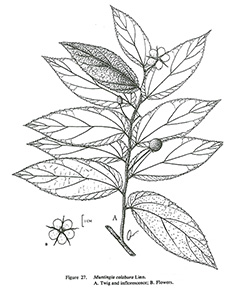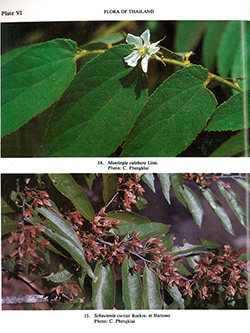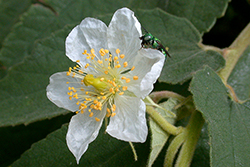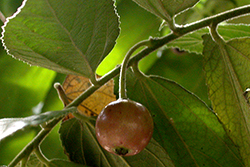e-Flora of Thailand
Volume 6 > Part 1 > Year 1993 > Page 43 > Tiliaceae > Muntingia
Muntingia calabura L.wfo-0000451606
Sp. Pl.: 509. 1753; Gagnep. in Fl. Gén. I.-C. 1: 562. 1911; Craib in Fl. Siam. En. 1: 193. 1925. Fig. 27; Plate VI: 14.
Accepted Name : This is currently accepted.
Description : Shrub to small evergreen tree, up to 10 m high, umbrella-like crown, twigs densely pubescent to glabrescent. Leaves (lanceolate) oblong, 5–10 by 1.5–3 cm; apex cuspidate; base oblique; margin serrate; secondary nerves 4–6 pairs, ascending towards the apex; scalariform veins distinct on lower surface petioles 2–5 mm long, pubescent. Inflorescence solitary, axillary; pedicels 1.5–3 cm long; flower buds ovate ± 5 by 4 mm, 0 apiculate. Sepals lanceolate, reflexed, densely pubescent on both sides. Petals spathulate, glabrous. Stamens glabrous. Ovary ovoid. Fruit baccate, globose ± 1 cm across, dark orange-red when ripe; fruit stalks, 2–3 cm long.
Thailand : Cultivated as a shade tree, spontaneous all over the country.
Distribution : Jamaica (type), introduced from tropical America. The plant was introduced into the Philippines in the second half of the 19th century. In the mainland of Asia, it was introduced into Singapore in 1910.
Ecology : Cultivated along roadsides as shade trees. Flowering and fruiting in all seasons.
Vernacular : Ta khop (ตะขบ), ta khop farang (ตะขบฝรั่ง)(Central); khop rang (ขบหรั่ง)(Peninsular).
Uses: Ripe fruit edible. Bark used for cordage.




